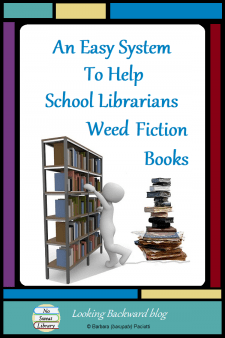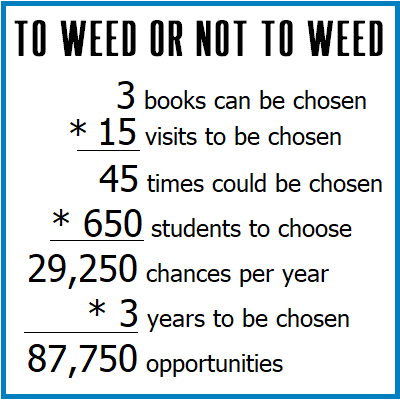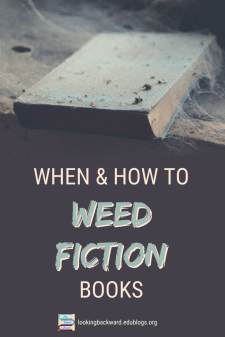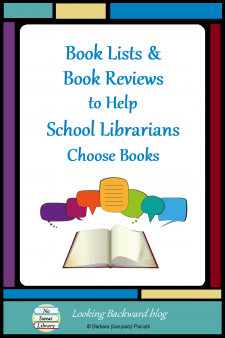 I don’t do books. … Wait…what?!
I don’t do books. … Wait…what?!
I realize this is a startling statement from a School Librarian, but let me clarify.
I’ve never been much of a “literary” reader, so I’m not adept at Fiction booktalks or book reviews nor can I “find the perfect book for a student.” As a former science & social studies teacher, I’m definitely a NON-fiction School Librarian.
So, when it comes to the Fiction area of our school library, I rely on book lists & book reviews from other library and education professionals, both to purchase books for our school library and to recommend books to students.
Here are the book list and book review sources I use to help me choose high-quality books for students. I think they can help you, too.
GREAT LISTS OF RECOMMENDED BOOKS
State Reading Lists
I love that here in Texas we have 10 different reading lists, for preschool to adult, all chosen by our Texas School Librarians. Half of the lists offer selections appropriate for the middle school students I serve:
- Lone Star – fiction & nonfiction for middle school: I get at least 2 copies of all of these every year.
- Tayshas – fiction & nonfiction for high school: I buy selected titles for our YA collection aimed at 8th graders.
- Maverick Graphic Novels – for grades 6-12: Nearly 3 dozen titles for middle-school-aged students.
- Spirit of Texas – by Texas authors & illustrators for grades 6-12: up to a half-dozen choices for middle school.
- Tejas Star – Bilingual/multicultural for ages 5 – 12: I ask Spanish teachers to select appropriate titles to support our IB second language program.
If your state offers reading lists—either from librarians or literacy teachers—take advantage of those vetted titles and buy two or more copies of every book that’s appropriate for the age & grade of your students.
You may also want to use other state award lists for additional titles to buy. A great source for those is Simon & Schuster’s Current State Award Master List webpage. Just click on a state in the list or on the map for their list of award or recommended books.
Association & Organization Book Lists
There are a few organizations that I trust to recommend great books for students. Here are my favorites:
The American Library Association is a one-stop shop for book lists. Their Association for Library Services to Children (ALSC) and their Young Adult Library Services Association (YALSA) have a variety of book lists:
- ALSC has 9 book & media awards along with a list of other organizations that have book awards. They also provide 3 different Children’s Notable lists, along with several topical lists, 9 for 2019-2020 and 10 for the 4 prior years.
- YALSA has 6 book awards and 6 topical book & media lists, along with 3 past topical lists.
The American Literacy Association has 3 “Choices Lists” elected by their readers: Children’s Choices, Young Adult Choices, and Teachers’ Choices.
The National Education Association‘s Read Across America has partnered with Colorín Colorado to create 10 lists to promote diversity, culture, and equity, including a list of books whose settings are in each U.S. state. They also offer 6 other organizational sources of book recommendations.
Book Vendors
Many large school library book vendors, such as Follett, offer customized lists or advanced sort features that produce a customized list. For example, you can sort by “popular” books or “best sellers” to find what other school librarians have purchased. I do this in the early spring to pick up titles I may have missed for my final book purchase of the school year.
You can also use the drop-down checklist of professional book review journals, such as School Library Journal and Voice of Youth Advocates, so you can specify starred or highly recommended titles to create your own quality list. This feature has rescued me from having to comb through piles of professional magazines for reviews of the best books to purchase.
There is one publisher with a book review site that I heartily recommend. Brightly, from Penguin Random House, offers thematic book lists & recommendations at 5 different age levels. Their Tween (ages 9-12) and Teen (13+) sections are very helpful for middle and high school librarians.
BOOK RECOMMENDATIONS FROM LIBRARIANS
Book Reviews By Librarian/Teacher Bloggers
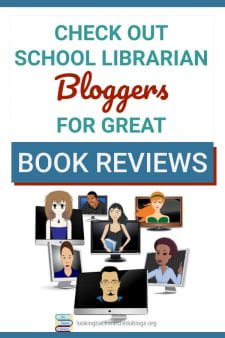 A number of School Librarians have created online book reviews for students and fellow librarians to learn about “good reads.” Here is a list of LM_NET and TLC listserv folks I rely on for good book reviews:
A number of School Librarians have created online book reviews for students and fellow librarians to learn about “good reads.” Here is a list of LM_NET and TLC listserv folks I rely on for good book reviews:
- Richie’s Picks – Richie reads a book nearly every week and posts his review to the LM-NET listserv. If you’ve missed them, you can search the LM-NET archive, but it may be easier to browse Richie’s Pbworks wiki-web site.
- Pamela Thompson is one of my favorite school librarians. She’s been reading and reviewing books for years and has a huge compilation on her website Young Adult Books-What We’re Reading Now.
- Mrs. Readerpants is another of my long-time favorite librarians. She has quite a few book reviews on her website, along with some “Genre Personality” information that can be helpful for students to identify their favorite reads.
- Barb Langridge has a wonderful collection of book reviews on her website, A Book and a Hug. Some have been contributed by teachers and students. She also has a Reader Personality Survey form for young folks to fill out and submit for an overview of their type along with a visual list of books they’ll enjoy reading.
- Laurie Evans reviews elementary & middle school appropriate books, which she has curated on her website, Blazer Tales. She offers 3 ways to sort and find the perfect books.
Here are other librarian & teacher bloggers who do regular book reviews, including student reviews which can be insightful for buying multiple copies of books. You may recognize a couple names as nationally-known authors:
- Nerdy Book Club is a group of 4 teachers, including Donalyn Miller of Book Whisperer fame, who write reviews of books for elementary through high school.
- Pernille Ripp is a middle school teacher who’s a passionate promoter of reading. Each year her students compose Our Favorite Books, a list with reviews of their favorite reads for the year.
- Books in the Middle are reviews from 5 librarians and teachers who work with middle school students. Their reviews cover a wide range of topics/genres.
- Literacy with Lesley is written by a teacher with 40-years experience in reading & writing. She regularly reviews books & compiles book lists on various topics, and has a wealth of ideas for book clubs.
- Libres is a website of professional book reviews by librarians & teachers in southeastern Michigan. They’ve been receiving publisher copies and reviewing books for 4 decades and once reviewed, the books are donated to schools and libraries in their geographic area.
- Gaijin School Librarian, aka Ashley Hawkins, hails from a high school in Brooklyn NY where she writes book reviews and recommended lists for manga graphic novels and anime. She has links to other places to find manga information.
Other sites recommended by fellow librarians:
- 62 great books by Black authors, recommended by TED speakers – These are recommended fiction & nonfiction titles that can bring diversity into your collection.
- Comics Laureate Recommended Reading List For Schools & Libraries – This is actually a comics store in the UK, but the owner has compiled this list of graphic novels based on his own readings. Good supplement to the GN librarian above.
Book Talks & Book Trailers
There’s nothing quite like a book talk to get students interested in books. Since I’m no good at booktalks, I rely on other sources to interest students in books.
One of those resources is the public library’s Youth Services Librarian. Our school boundaries encompass 2 different public libraries, and both allow crossover access for our students. I have the benefit of 2 wonderful ladies who I invite to our school 4 times a year for booktalks and to promote public library activities to our students: early fall after school begins, and before our winter, spring and summer breaks. It’s a WIN-WIN for me, for them, and especially for our students.
Combining the best of booktalks and online book reviews are online video booktalks. Here are two you won’t want to miss:
- Naomi Bates has written book reviews for years on her blog, YA Books & More. Now she’s upped her presence to a vlog—a video blog—where she booktalks a new book nearly every week. You can also use the playlists on her YouTube site to show a series of video booktalks while your students are browsing for books!
- Colby Sharp, one of the “nerds” from the Nerdy Book Club, has an amazing YouTube site with lots & lots of video booktalks!
Students love book trailers, and so do I. They’re like movie previews only better, because you can create a QR link code and tape it onto the book so kids can use their smartphones to view the trailer when they pull a book off the shelf. Here are two good resources for book trailers:
- Jill Slapnik has a YouTube channel with a huge Playlist of Book Trailers for Middle School—literally hundreds of them.
- Book Trailers For All has been around for quite awhile, so you can find video trailers for older books as well as newer titles.
PROMOTE READING WITH FIRST-LINERS & BOOKMARKS
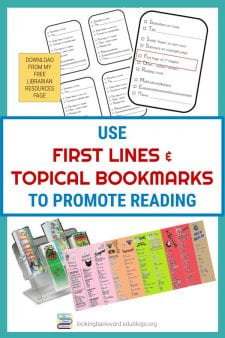 One way I help students find a book that appeals to them is with my IT IS FOR ME checklist, where the F is for the First page of the book. When I get new books in, I scan the first pages to find really catchy first lines. At a library visit I read these first-lines to students to emphasize why opening the book and reading the first page is worthwhile.
One way I help students find a book that appeals to them is with my IT IS FOR ME checklist, where the F is for the First page of the book. When I get new books in, I scan the first pages to find really catchy first lines. At a library visit I read these first-lines to students to emphasize why opening the book and reading the first page is worthwhile.
Though I’m not so good at book reviews or booktalks, I put special effort into creating “if you like this, you’ll also like…” bookmarks for students. I have templates for 21 different topical & series bookmarks, which I place in Demco acrylic displays on top of the circulation counter. Our Fiction area is organized by Subjects using color-coded sticker labels & transparent label covers. so I copy bookmarks to cardstock that matches the color for the Subject so students know where to go to find the books.
Many School Librarians love reading books from their school library and doing booktalks & book reviews. For those of us who don’t, we can benefit from these folks and return the favor by blogging about what we do do best!
![]()


